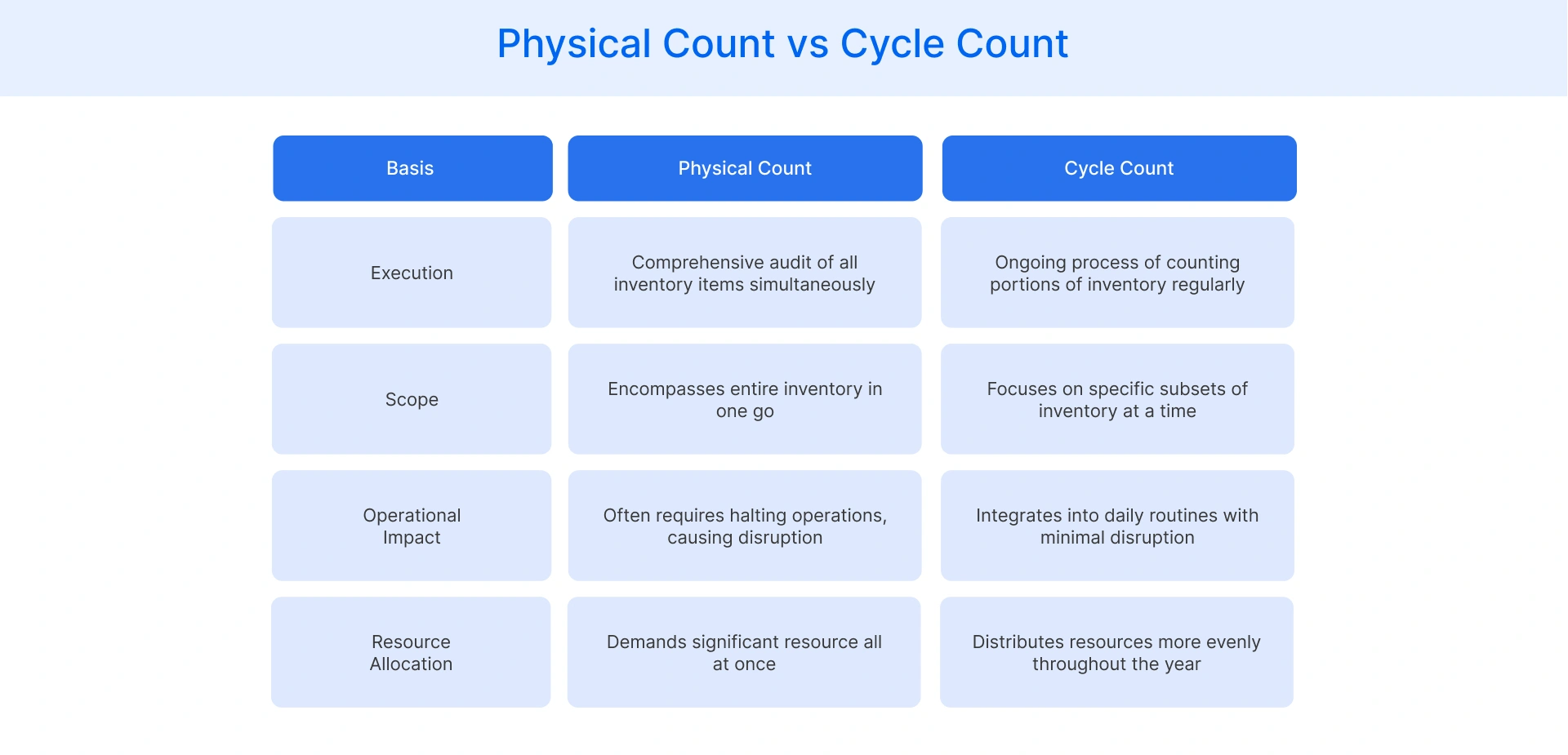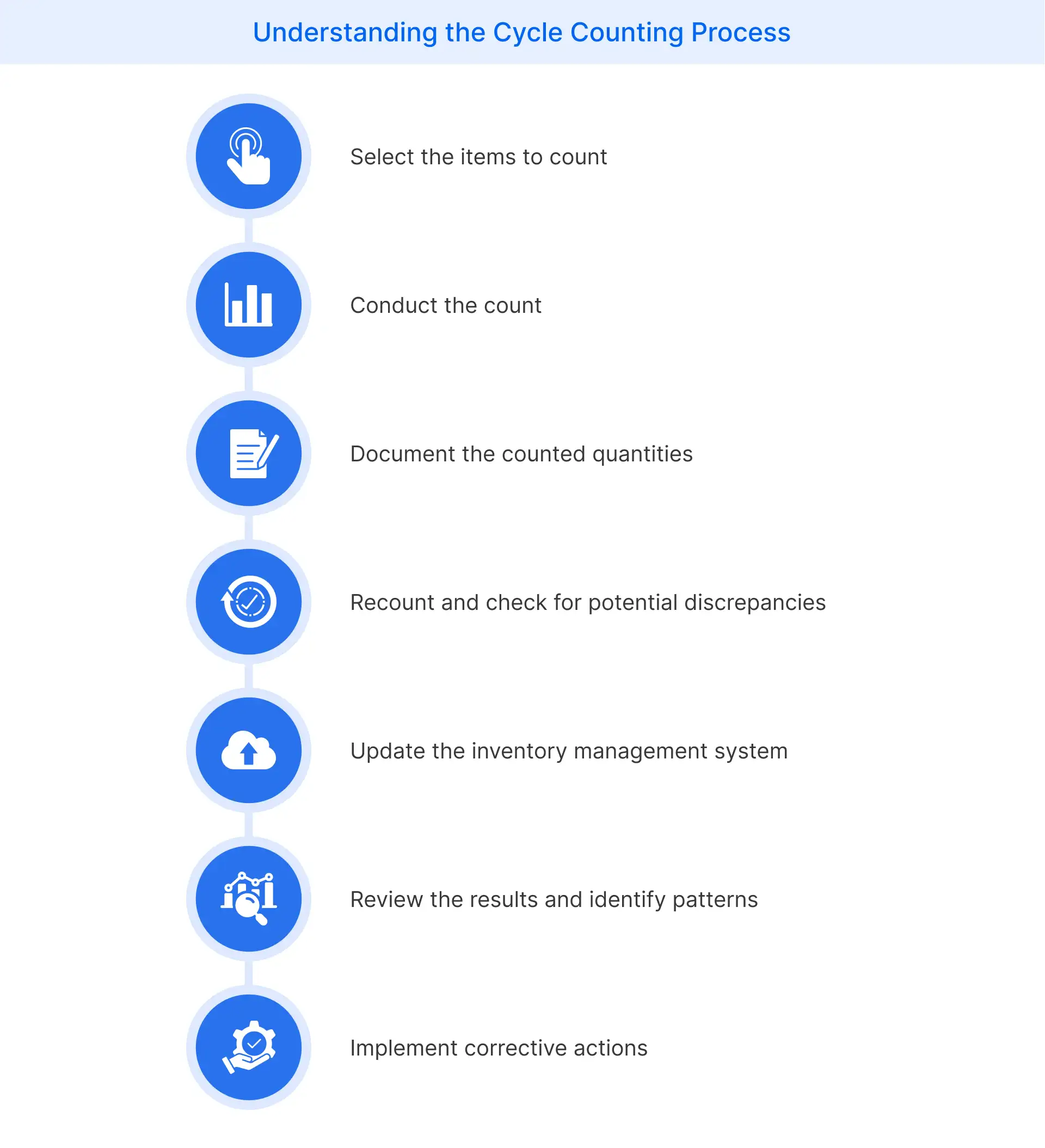Table of Contents
- What is Cycle Counting?
- Types of Cycle Counting Methods?
- Difference Between a Physical Count and Cycle Count
- Benefits of Cycle Counting
- How to Do Cycle Counting?
- What is the Ideal Frequency of Cycle Counting Methods?
- What are the Best Practices for Inventory Cycle Counting?
What is Cycle Counting?
Cycle counting is a structured inventory control process where selected items are counted at regular intervals instead of conducting a complete physical count. This method allows you to track stock levels continuously without halting business operations.
Unlike traditional stocktaking, which occurs annually or quarterly, cycle counting integrates seamlessly with daily workflows and helps detect discrepancies early. This inventory management strategy enables prompt corrective actions, reduces inventory errors, and supports informed decision-making. Businesses typically segment items based on value, frequency of use, or storage location to decide which items to count and when.
As a result, cycle counting improves inventory record accuracy, prevents overstocking or stockouts, and strengthens inventory accountability. This technique can ensure real time visibility of inventory data, enhance operational efficiency, and reduce the risks associated with large-scale stock variances.
Cycle counting process is especially beneficial for high-volume retail environments where uninterrupted processes are crucial for customer satisfaction and supply chain performance.
Types of Cycle Counting Methods?
Cycle counting methods vary across industries and situations, each designed to address specific needs and optimize accuracy. Here are the most popular approaches:
ABC Analysis Method
The ABC cycle counting method categorizes inventory items based on their value and usage frequency. A items, being high-value and frequently used, are counted more often than B or C items. The ABC method ensures that your most critical inventory receives the most attention, optimizing resource allocation and maintaining accuracy where it matters most.
Random Sample Counting
In this method, you select a given number of items for counting at random, ensuring that all inventory has an equal chance of being audited. Random sampling helps maintain overall inventory accuracy by preventing predictable count patterns. The random sample cycle counting method is particularly useful for detecting systematic inventory discrepancies or potential theft issues across your entire inventory.
Geographic Method
The geographic method organizes cycle counts based on the physical location of items within your warehouse or store. You systematically count items in specific areas, moving through your facility in a predetermined pattern. This approach ensures comprehensive coverage over a specific time period and can be particularly effective for large warehouses or retail spaces.
Usage-Based Counting
Usage-based counting focuses on items with high transaction frequency. By prioritizing frequently moved inventory, you address the areas most prone to discrepancies. This method helps you quickly identify and correct variances in your most active stock, ensuring accuracy for items that have the most significant impact on your daily operations.
Difference Between a Physical Count and Cycle Count
Physical counts and cycle counts are two distinct inventory management approaches. While both methods aim to verify inventory accuracy, they differ significantly in their execution and impact on business operations.
- Execution: Physical counting involves a comprehensive audit of complete physical inventories simultaneously, typically annually or semi-annually. Cycle counting is an ongoing process where you count a portion of your inventory regularly, allowing for continuous accuracy checks throughout the year.
- Scope: Physical counts cover your entire inventory in one go, providing a complete snapshot of stock levels. Cycle counts focus on specific subsets of inventory at a time, allowing for targeted audits of high-value or fast-moving items.
- Operational Impact: Physical counts often require halting operations for a period, which can be disruptive to your business. Cycle counts can be integrated into daily routines with minimal disruption, allowing for continuous inventory management.
- Resource Allocation: Physical counts demand a significant period of time and labor resources all at once. Cycle counts distribute these resources more evenly throughout the year, making them less labor-intensive.

Benefits of Cycle Counting
The cycle count process offers significant operational and financial benefits for modern inventory management systems in retail and warehouse settings.
- Improved inventory accuracy: Regular cycle counting helps detect discrepancies quickly, enabling timely corrections. This inventory counting method ensures recorded stock levels align with actual inventory, reducing errors in procurement and reporting.
- Reduced carrying costs: Accurate inventory tracking prevents overstocking and unnecessary purchases. You can maintain optimal stock levels, minimize storage expenses, and reduce capital tied up in large inventory levels.
- Enhanced decision-making: Reliable inventory data from cycle counting supports better demand forecasting and purchase planning. It helps businesses make timely decisions based on the current availability of different types of inventory.
- Continuous operational flow: Unlike full physical counts, cycle counting does not disrupt routine business operations. Inventory can be verified without halting sales, shipping, or warehouse operations.
How to Do Cycle Counting?
Effective cycle count method requires a structured process to maintain accurate inventory records without interrupting operations.
- Select the items to count based on your chosen method (ABC, random, geographic, or usage-based). Ensure counters have the necessary tools and training.
- Conduct the count without referencing current inventory records to avoid bias. Count thoroughly and accurately, noting any damaged or misplaced items.
- Document the counted quantities and compare them to your inventory management system. Identify and flag any discrepancies for further investigation.
- For items with discrepancies, recount and check for potential causes such as miscounts, theft, or data entry errors.
- Update your inventory management system with the correct quantities. Document the reasons for any adjustments made.
- Review the results to identify patterns or recurring issues. Use this information to improve your inventory management processes.
- Implement corrective actions based on your findings, such as adjusting reorder points or addressing storage issues.

What is the Ideal Frequency of Cycle Counting Methods?
The ideal frequency for cycle counting depends on various factors, including inventory turnover, item value, and your business needs. Here is a guide to help you choose the right frequency:
Daily Counts:
- Ideal for high-value items (A-class in ABC analysis)
- Best for fast-moving inventory with frequent transactions
- Suitable for businesses with critical stock accuracy requirements
Weekly Counts:
- Appropriate for medium-value items (B-class)
- Useful for moderately fast-moving inventory
- Good for maintaining overall accuracy without daily commitment
Monthly Counts:
- Suitable for low-value items (C-class)
- Effective for slow-moving inventory
- Helps maintain accuracy for less critical items
When selecting a frequency, consider your resource availability and the impact of potential discrepancies. Adjust your cycle counting frequency based on your findings and changing business needs to optimize your inventory management process.
What are the Best Practices for Inventory Cycle Counting?
To maximize the effectiveness of your cycle counting program, consider implementing these best practices:
- Leverage barcode scanners, RFID technology, or inventory management software to streamline the counting process and reduce human error.
- Ensure all personnel involved in cycle counting are well-trained in proper procedures, equipment use, and data entry techniques.
- Develop and document standardized counting methods to maintain consistency across different counters and locations.
- Assign different staff members to count the same areas periodically to prevent complacency and reduce the risk of systematic errors.
- Regularly review cycle count data to identify trends, recurring issues, or opportunities for inventory optimization.
Conclusion
Cycle counting plays a vital role in maintaining accurate inventory records without disrupting daily operations. It allows you to verify stock in smaller and manageable batches to detect discrepancies early. When implemented consistently, it supports better inventory visibility and improves overall operational control. For retail and e-commerce businesses, adopting this method ensures accurate data, reduces carrying costs, and enhances customer satisfaction through timely and precise inventory management.
FAQ
In lean inventory management, cycle counting is crucial for maintaining accurate stock levels without excess buffer inventory. It helps identify inefficiencies, reduces waste, and supports just-in-time ordering. By providing real-time inventory data, cycle counting enables you to optimize stock levels and respond to changing demand patterns quickly.
While cycle counting significantly improves inventory accuracy, it may not entirely replace annual physical inventories in all cases. Some businesses still perform yearly counts for financial reporting or regulatory compliance. With a well-implemented cycle counting program, you can potentially reduce the scope and disruption of these annual counts.
Prioritize items for cycle counting using the ABC analysis method. Focus on high-value, fast-moving ‘A’ items more frequently, followed by moderate ‘B’ items, and then lower-value ‘C’ items. Consider factors like theft risk, seasonality, and historical accuracy issues when setting your counting schedule for best results.
Cycle counting helps detect theft by revealing discrepancies between recorded and actual inventory levels. Regular counts allow you to spot patterns of unexplained losses, particularly in high-value items. This early detection enables swift investigation and implementation of loss prevention measures, reducing overall shrinkage in your retail operation.

